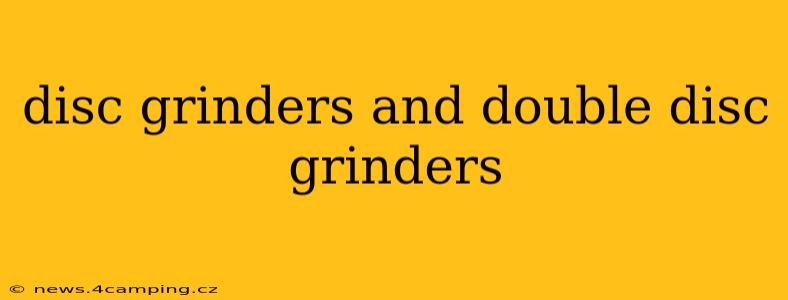Choosing the right grinder for your needs can be tricky, especially when faced with options like single disc grinders and double disc grinders. This comprehensive guide will delve into the differences, advantages, and disadvantages of each, helping you make an informed decision. We'll explore their applications, safety considerations, and factors to consider when purchasing.
What is a Disc Grinder?
A disc grinder, also known as a single disc grinder, is a power tool featuring a single abrasive disc mounted on a rotating spindle. This simple design makes them versatile and relatively inexpensive. They are primarily used for grinding, sharpening, and deburring various materials, from metal and stone to wood and plastic. The speed and aggressiveness of the grinding action are controlled by factors like the disc's grit and the grinder's speed settings.
What is a Double Disc Grinder?
A double disc grinder, as the name suggests, features two abrasive discs mounted on parallel spindles, rotating in opposite directions. This unique configuration allows for simultaneous grinding of two surfaces, significantly increasing efficiency and potentially improving surface finish consistency compared to a single disc grinder. It's ideal for tasks requiring symmetrical shaping or consistent material removal from both sides of a workpiece.
What are the Advantages of a Disc Grinder?
- Versatility: Single disc grinders handle a wide range of materials and applications.
- Cost-effectiveness: Generally more affordable than double disc grinders.
- Maneuverability: Easier to handle and maneuver in tight spaces.
- Simplicity: Easier to operate and maintain.
What are the Advantages of a Double Disc Grinder?
- Increased Efficiency: Simultaneous grinding of two surfaces drastically reduces processing time.
- Improved Surface Finish: The opposing rotation can lead to a smoother, more consistent finish.
- Improved Accuracy: The symmetrical action allows for more precise shaping and sizing of workpieces.
- Enhanced Safety (in some cases): The opposing rotation can help prevent workpiece binding, potentially reducing kickback.
What are the Disadvantages of a Disc Grinder?
- Slower for symmetrical tasks: Grinding both sides requires separate operations.
- Potentially less precise: Achieving perfect symmetry can be challenging.
What are the Disadvantages of a Double Disc Grinder?
- Higher Cost: Generally more expensive than single disc grinders.
- Less Versatile: Primarily suited for symmetrical grinding tasks.
- Space Requirements: Needs more space for operation than a single disc grinder.
- Safety Concerns (if not used correctly): Can be dangerous if not operated with proper caution and safety measures.
What are the Different Types of Abrasive Discs Used in Disc Grinders?
Both single and double disc grinders utilize various abrasive discs tailored to specific materials and applications. These include:
- Metal Grinding Discs: Designed for grinding and shaping metal.
- Stone Grinding Discs: For grinding and polishing stone.
- Wood Grinding Discs: Specialized for smoothing and shaping wood.
- Deburring Discs: For removing burrs and imperfections from edges.
What Safety Precautions Should I Take When Using Disc Grinders?
Safety is paramount when operating disc grinders. Always:
- Wear appropriate safety gear: This includes eye protection, hearing protection, a dust mask, and work gloves.
- Use the correct disc for the material: Using the wrong disc can lead to breakage and injury.
- Secure the workpiece: Ensure the workpiece is firmly clamped or held to prevent accidental movement.
- Maintain a firm grip: Avoid losing control of the grinder.
- Inspect discs regularly: Check for cracks or damage before each use.
- Follow manufacturer's instructions: Carefully read and follow the instructions provided with your grinder.
Which Type of Grinder Should I Choose?
The choice between a single and double disc grinder depends entirely on your needs and applications. If you need a versatile tool for a wide range of grinding tasks and don't require high-speed, symmetrical grinding, a single disc grinder is suitable. However, if your work involves frequent symmetrical grinding and requires high efficiency and precision, a double disc grinder is the better choice. Consider your budget, workspace, and the types of materials you'll be working with when making your decision.
How do I maintain my disc grinder?
Regular maintenance is crucial for extending the lifespan and ensuring the safe operation of your disc grinder. This includes regularly inspecting and replacing worn abrasive discs, cleaning the grinder of debris, and lubricating moving parts as recommended by the manufacturer.
This comprehensive guide provides a solid foundation for understanding the differences between single and double disc grinders. Remember to always prioritize safety when using any power tool.
